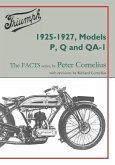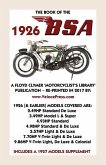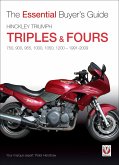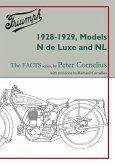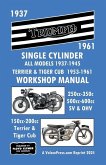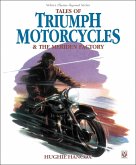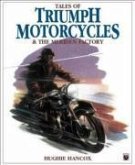Triumph Models N, NP and QA-2 1927-1928 The 1927 Model N was a logical progression from the very successful 494cc 1925/26 Model P. Basically the same engine was used with the addition of an internal "semi-automatic" oil pump along with the later evolvement of the Model P gearbox. These were placed into an updated frame with Webb single-spring forks and a brake-shoe rear hub replaced the long-used dummy belt-rim brake. The single internal band front brake remained but beaded edge tyres disappeared for ever and wired-on rims and tyres were fitted. A few other minor changes but hey presto a Model N, and another success story for Triumph. Initially announced as the Model 'N de Luxe' this was to later lead to confusion when for 1928 the machine was modernised to have a saddle tank and the updated machine was known as the 'N de Luxe', while the 'N' continued for the 1928 season but was listed as the Model NP. Consequentially in order to avoid confusion the 1927 machine has become more commonly known as the straight 'Model N' and that is the reference I shall use in this book; while the 1928-29 saddle tank Model N de Luxe is the subject of a separate book. The Model QA came in two varieties; hence my non-official naming of 'QA-2' in the book title. In 1926 a Sports version of the Model P was announced - the Model Q, and also a Super Sports - the Model QA. However, the 1926 Model QA owed more to its Model P ancestry than the Model QA of 1927, which was the sports version of the Model N. Thus this book will relate only factors relative to the 1927 Model of the QA. ---------- The early decades of the 20th century was an exciting period of innovation in automotive history when travel options were limited and the freedom of motorcycling was a real adventure. Are you are restoring one of these early Triumph motor cycle? Interested in motorcycling history? Needing the correct historical FACTS for your book or film project? Or researching aspects of your family history. Then this book, being filled with accurate technical details; images and diagrams from the period; and historical information - The FACTS - is for you. Each book within the Triumph The FACTS series, is the result of patient, dedicated and meticulous research by the author to cover a single motor cycle model, or common range, in detail. This series of The FACTS books has been titled due to a remark from someone whom Peter assisted with his restoration. "Over the years many people have given me advice but you are the only one who has ever given me FACTS!" ---------- On Nov 14th 1940, the Triumph factory was destroyed in the air raid on Coventry. All records were lost of models built, their dates and total numbers. 4 decades later, in the early 1980's, Peter Cornelius accepted the challenge to accurately date every pre-1940 Triumph motor cycle, and spent the following 4 decades intimately researching the details of every pre-1940 Triumph, to rediscover the 11 missing coding systems. Recognised as a global authority on Vintage Triumph motor cycles, a Marque Specialist for the Vintage Motor Cycle Club in the UK even when he emigrated to NZ, Peter is the author of 28 books on Triumph history before 1940.
Hinweis: Dieser Artikel kann nur an eine deutsche Lieferadresse ausgeliefert werden.
Hinweis: Dieser Artikel kann nur an eine deutsche Lieferadresse ausgeliefert werden.


